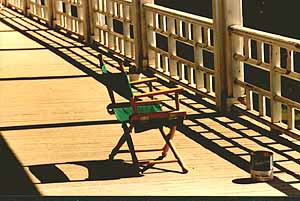 |
WAWONA
|
||
October 7, 2010Wawona's BookOctober 7 marked ten years since the death of Wawona Washburn Hartwig. Born in 1914, she lived most of her first seventeen years in the Wawona Hotel. She spent a good deal of her later years working on a history book about the Wawona – a project she never completed. At age 17 she was advised by a handwriting analyst, “Why not write eventually? Your life’s experiences must be colorful even so far.” Fifty-nine years later Wawona shifted in her hospital bed, perhaps a week before she died, and said to me, “I feel like I could get back to work on the book, today!” She had intended to create an epic history with colorful accounts filled with detailed backgrounds and verisimilitude (she liked that word), with Indians, explorers, cowboys, loggers … all sorts of characters and wild stories. She absolutely loved to “set the record straight” on disputed topics of local anecdotal history by quietly producing a telling photo, document, or a quote from her father’s diary, and her book would have been filled with such triumphs. Shortly after her death, executor Jack Gyer and several of Wawona’s heirs gathered to read the will. It was determined by the group that I should take on the job of completing the book. This is an update on my progress. Wawona’s research was organized in file drawers with folders marked “Golf” or “Stages” or “Thomas Hill,” etc. The folders held handwritten Post-it notes, newspaper clippings, letters, copies of deeds, maps – just all kinds of data. She’d written some chapters, full of false starts, re-writes and edits. There were few source-references in her drafts, but Wawona had repeatedly told me how important it was to “get the story right,” and I soon realized the enormity of the responsibility I’d taken on. First I studied published books with Wawona-related history. These were filled with information, but were mostly empty of references to the sources of the information. In many cases the National Park Service reports used these largely unsupported histories as references. In order to honor Wawona’s intention to be accurate, I would have to find the missing primary sources for all these facts and dates. After setting up a regimen for tracking my research, I started by plodding through the Mariposa Gazette on microfilm – every page from 1854 to 1901. When I was done, I went through it all a second time to make sure I hadn’t missed anything. I’ve methodically combed through several other large bodies of historical data, and am nearly finished organizing and studying all of Wawona’s research including her father’s diaries from 1914 to 1934. I’ve about 900 pages left to go through. I hope to finish the main body of research by early next year, after which I should be adequately prepared to do justice to Wawona’s legacy by finishing her book. I plan to present as best I can what Wawona’s book would have looked like, including as much as possible of her own writing, with plenty of footnotes and source attributions. I also hope to tell the story of her interaction with the hotel and its history, and how she tried to balance her identities as historian, historic figure, and vital, fascinating woman in her own right. I also plan to produce a video documentary, perhaps a CD of interviews, and eventually an anthology of the hundreds of news articles, letters and documents that I’ve found. But don’t hold your breath. Having devoted most of my free time working away at this project, I’ve noticed how ten years of living can get in the way, and now appreciate why Wawona’s project may have required more than one lifetime to accomplish. Tom Bopp Musician/Historian, Wawona Hotel
|
|||